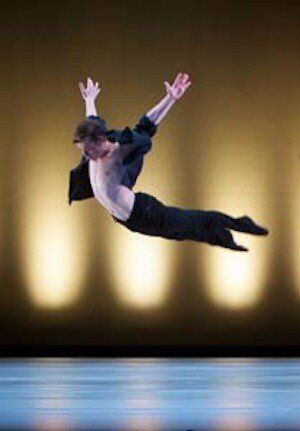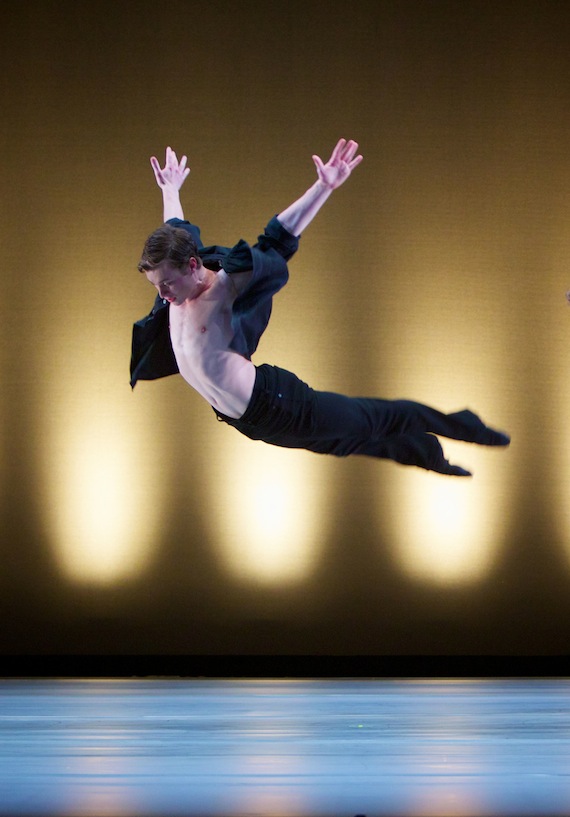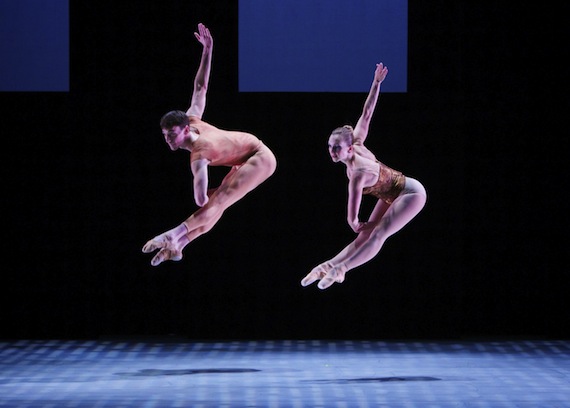
Ballet to the People sacrificed an opportunity to cheer on her beloved San Francisco Giants Wednesday night as they rallied to tie the Miami Marlins in the ninth inning. Instead she had the pleasure of watching the superb athletes of Smuin Ballet go 3-for-3 in an outstanding mixed bill at the Yerba Buena Center for the Arts.
 John Speed Orr in Val Caniparoli's Swipe. Photo: Keith Sutter
John Speed Orr in Val Caniparoli's Swipe. Photo: Keith Sutter
Kicking off with Val Caniparoli's Swipe -- set to a pulsating techno score by Gabriel Prokofiev (yes, the grandson of the great Russian composer) whose ingenuity kept this from being just another cause for migraine -- Smuin dancers nailed the fresh and compelling choreography that, while nodding to hip-hop, jazz and African movement, stayed firmly within the neoclassical mold, with crisp pointework, conventional pirouette preparations and a variety of takes on the pas de basque. There was no yearning for deep meaning here -- just pure reaction to the driving beat, climaxing in a variation for four men who advanced toward the audience in a bravura sequence of rapid, syncopated side kicks, their formation recalling the faintly menacing men's quartet in Paul Taylor's Cloven Kingdom. Throughout, the dancers created beautiful, sometimes startling, shapes in the air that occasionally elicited an emotional reading. In a particularly affecting moment, Susan Roemer, held in a tight clinch by Jonathan Dummar, dove head first toward the floor from the height of a lift, her body inscribing a circle in the air in slow motion as she descended.
The high-octane Swipe would have been a more suitable closer than Michael Smuin's majestic and somber Symphony of Psalms from 2006, set to an anguished score by Stravinsky. This mysterious piece evoked an underwater world, as enormous, translucent, iceberg-like structures were hoisted into the air at the beginning of the piece to reveal the inhabitants trapped in this world. The vocabulary was far more classical than the other two pieces, although the dancers often wrapped themselves around each other in distinctly modern, architectural shapes. The fiendishly difficult partnering included many upside-down lifts and promenades with the women's extensions at full height. The women resembled radiant, bare-legged ice queens in gorgeous Esther Williams-like costumes, although their consorts looked slightly outlandish in powder-blue short shorts and silky turtlenecks.
 Jonathan Dummar and Robin Cornwell in Ma Cong's Through. Photo: Keith Sutter.
Jonathan Dummar and Robin Cornwell in Ma Cong's Through. Photo: Keith Sutter.
Sandwiched between these two ballets, Ma Cong's new Through, though plotless like the other two, conveyed more emotion and hinted at passionate back stories. The dancers rose above the unflattering costumes and the creaky-door score by Ryuichi Sakamoto, which thankfully morphed into something more musical and danceable a third of the way through. Lots of difficult pointework in forced arch, and off-balance partnering, with a few injections of classical technique like quick fluttering bourrées, marked this absorbing work. But the technique was secondary to the many moments of wit and tenderness -- as when the women placed their arms around their partners' shoulders and softly touched the back of their necks, or when the women leaned into the men as if unable to stand on their own and were towed gently along the floor (this last movement reminiscent of Lar Lubovitch's iconic Concerto Six Twenty-Two). Altogether a visually and emotionally satisfying piece.
The entire program showcased the impressive physiques and strong classical technique of this small company. The women in particular, with their wide shoulders and muscular, pliant backs exemplify the modern American ballerina in the post-Balanchine era. The men are no slouches, either. Technique is so strong in this company that even when a dancer appears to be falling off balance in a multiple pirouette or landing a jump, they are able to make tiny adjustments to fix the problem. This technical confidence permits them to throw themselves with abandon into the choreography.
During the curtain call, the disheartening news that the Giants had lost in the 10th -- when Santiago Casilla surrendered a home run to Marlins outfielder Giancarlo Stanton -- was conveyed quietly to Ballet to the People by her Blackberry-wielding date. No one else in the audience seemed to care.
Meanwhile, a few blocks away at the War Memorial Opera House, audiences were gamely sitting through the lavish but interminable full-length Don Quixote. (A little Minkus goes a long way -- which is why most companies choose just to stage the 3rd Act.) Not the cleverest programming choice for San Francisco Ballet, on the heels of the American première of Alexei Ratmansky's version, presented in February with great style by Pacific Northwest Ballet. The joint choreographic efforts of Tomasson and Possokhov could not hold a candle to Ratmansky's lively, erudite and inventive re-imagining of this war-horse. But there was plenty of eye-candy and dazzling pyrotechnics from the large stable of talent at SFB. All in all, a great week for ballet -- if not baseball -- in San Francisco.
Smuin Ballet's season continues through May 27th in various locations around the San Francisco Bay area, and Smuin Ballet will also appear at the Joyce Theatre in New York City from August 13-18, 2012.
